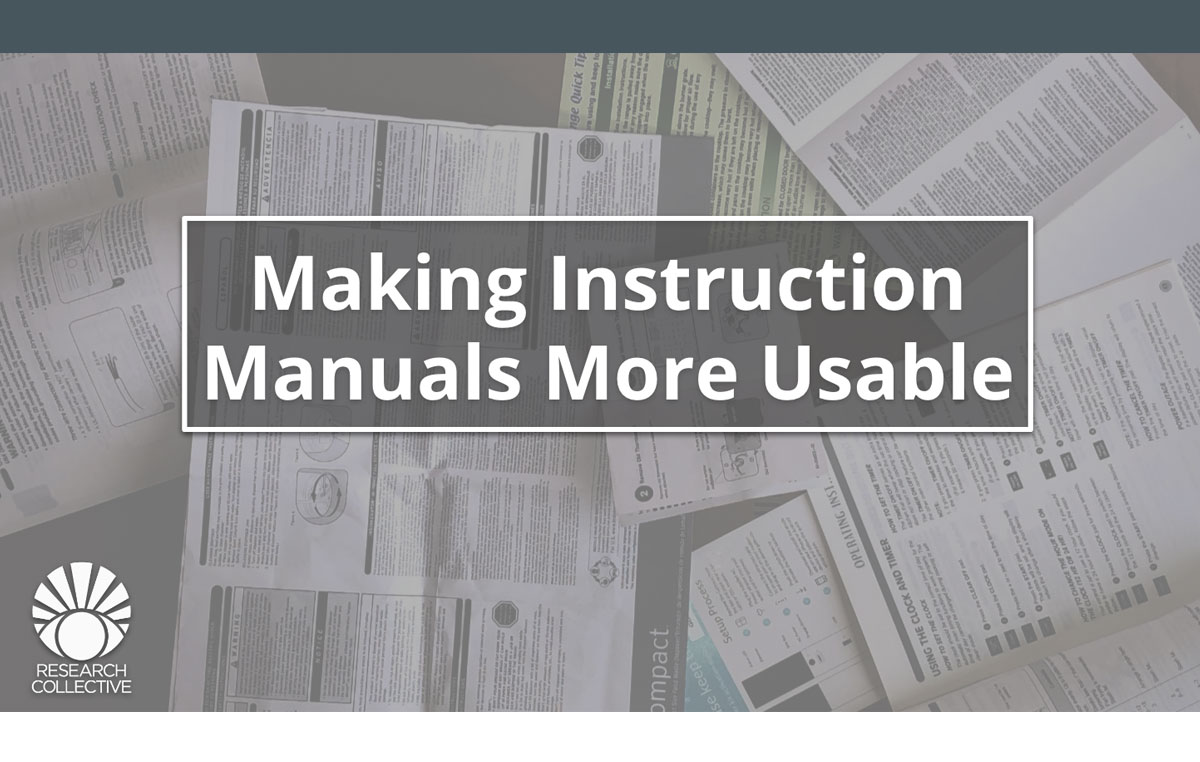Instructions for Use
All too often, creating an instruction manual for a new and innovative product is a mere afterthought. Indeed, you can make a strong bet that good and usable instruction manuals just aren’t very common. But here’s the thing: user-friendly instructions for use (IFUs) can be quite important, especially for products like medical devices or dangerous equipment. Users need to know how to use a product effectively and safely, and they need to be aware of any risks associated with the product’s use.
While saying “reading instruction manuals is fun” fools no one, IFUs are often the first (and maybe only) resource users have during product-familiarization or troubleshooting. Even if a user learns how to use a product through alternative methods, such as word-of-mouth or formal training, those instructions still need to be provided in a user manual.
Manufacturers simply need to know how to provide usable instructions for use. While not exhaustive or comprehensive, this list is a compilation of seven guidelines which, if product manufacturers can apply correctly, will help users search through, comprehend, and apply what they read in instruction manuals.
1. Font: Stick to the Basics
 Fonts used in instruction manuals should facilitate understanding of the content. There is no need to make an instruction manual look innovative, ornate, or lavish; black Arial text on white background will suffice. Standard san-serif fonts are usually a safe option, but many manuals use classic serif typefaces like Times New Roman that were designed for legibility.
Fonts used in instruction manuals should facilitate understanding of the content. There is no need to make an instruction manual look innovative, ornate, or lavish; black Arial text on white background will suffice. Standard san-serif fonts are usually a safe option, but many manuals use classic serif typefaces like Times New Roman that were designed for legibility.
Along the same line, avoid using multiple font styles. In an IFU, content is truly king and using more than two typefaces can be extravagant. If you need to somehow differentiate one line of text from another, bold, italics, underline, or even indentation can probably do the trick.
2. Consider the User
Just as any product should be engineered with the end-user in mind, the same ground rule should be followed for IFUs. If you leave this article having learned just one thing, it is exactly that.
Who is the product designed for? Will it be used by general population? Will only neurosurgeons will have access to the product?
There are myriad characteristics to consider when writing a usable IFU. Perhaps the best place to start is to determine what the user is expected to know already. If your product is a highly complicated surgical instrument, it is safe to assume that the people reading the product’s IFU already know certain things. You probably don’t need to explain the difference between an artery and a vein, for example. Meanwhile, if the product is a mobile device, the fact that anyone could use it someday teaches you something: some users will be techies and some users will be clueless. Always design for the user who will need most help.
Reading level, cognitive ability, and physical ability also change how manufacturers should approach an IFU. Instructions designed for lay-users might need to be written at a 5th-grade reading level whereas instructions designed for a neurosurgeon can be a bit more advanced. Likewise, IFUs that will be read by elderly users should consider possible cognitive decline and poor vision. It might be beneficial to break down steps even further and increase font-sizes in those scenarios.
3. Consider the Use Environment
Not everyone gets to sit at their quiet, well-lit desk to read an instruction manual. In which situations and where is the product expected to be used? Maybe it’s at home or at work. Or perhaps during emergencies!
The use environment can include a wide range of distractions, noises, and even lighting. Each of these variables must be considered when writing usable instructions for use. Will the user keep the IFU with them at all times? Will they be nearby? Might the IFU be somewhere else altogether?
Even something as simple as the manual’s physical form could be impacted by these factors. Instruction manuals are traditionally printed on paper. They might be folded, bound, or provided electronically, but paper is certainly the most popular medium. But consider this, would you want the instruction manual for your brand-new power washer to be made out of material that would be ruined if it got wet? Or even worse, what if the IFU for your new shredder was made out of paper?! Oh, the humanity!
4. Minimize the User’s Cognitive Load
One of the reasons multitasking can be so difficult is something called cognitive load. As humans, our minds can manage only a small amount of information at a time. Research shows that we can manage roughly 4-7 pieces of information before memory fails (Miller, 1956; Cowan, 2001).
Our ability to multitask has taken our species a long way, but it certainly has its limitations. Fortunately for us, instruction manuals can be written such that the user is not forced to remember multiple things at a given time. By writing short, action-based steps and presenting critical information redundantly, users can focus on the content provided at each step and not waste valuable brainpower trying to remember other details. As a general rule, always reduce the user’s need to remember information, even if length is added to the document. It is easier to remember where the information is than what the information is.
5. Use Tools for Emphasis
In theory, all the information in an instruction manual is important. But of course, special attention must be paid to certain content. For this reason, don’t be afraid to employ, ALL CAPS, color, bold, italics, or underline for emphasis of important details. These typeface formatting tools were invented for a reason; use them!
However, there is a caveat. Avoid using all caps, color, bold, italics, or underlining a whole sentence. This distraction slows down processing and simply makes the text difficult to read. It also completely negates the point of using these tools, which is to emphasize importance.
Consider these two examples:
A: “Fill the black container with 300 mL of saline solution.”
B: “Fill the black container with 300 mL of saline solution.”
Consider further that it is absolutely crucial that exactly 300 mL of the saline solution is poured and that filling any container other than the black one could actually lead to someone getting hurt. Which would you rather have?
A and B say the same thing, but the points of emphasis are notable, given the context. Sentence A emphasizes the two important parts and sentence B might as well be written in plain text.
6. Organize Content Intuitively
While product manufacturers should certainly focus on clear and usable content, the way information is organized is also extremely important. The most basic way to organize content intuitively is simply to put related information together. By nature, people tend to expect elements that are near to one another to be related. There is no need to violate this assumption.
Another helpful tip is to outline properly. We all learned this simple strategy in middle school, but indentations help users figure out which steps are tasks and which are subtasks. And knowing when to use a bulleted list versus a numbered list will serve product manufacturers well.
7. Test It Out
Development teams all over the world try to design their product with the end-user in mind, but that doesn’t mean their efforts are 100% successful or flawless. Sometimes there is simply no substitute to usability testing to test out the design.
Instruction manuals are no different! Get the manual in front of a representative end-user and see if they can follow your instructions properly. It can be iterative. The user manual you test with users does not need to be the final product; feel free to use rough drafts. By doing so, you can identify usability issues early on in the creation process.
Conclusion
Instructions for use are frequently an indispensable resource for end-users of all products. And while it isn’t always easy to accomplish, there are many contributing factors when it comes to developing usable instructions for use. From basic design principles to true usability strategies, product manufacturers can use guidelines like these to create instruction manuals that are actually helpful.
For more Medical Human Factors Engineering and User Experience resources visit our blog and YouTube channel.
